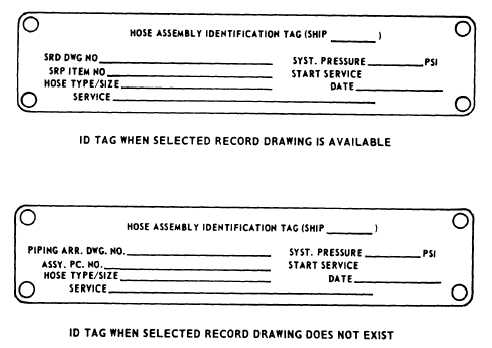3. be designed to give adequate performance and
service for infrequent transient pressure peaks
up to 150 percent of the working pressure of
the hose, and
4. have a safety factor with a burst pressure at
a minimum of 4 times the rated working
pressure.
There are temperature restrictions applied to
the use of hoses. Rubber hose must not be used
where the operating temperature exceeds 200°F.
PTFE hoses in high-pressure air systems must not
be used where the temperature exceeds 350°F.
PTFE hoses in water and steam drain applications
must not be used where the operating temperature
exceeds 380°F.
FABRICATION AND TESTING
The fabrication of flexible hose assemblies is
covered in applicable training manuals, technical
publications, and NAVAIR 01-1A-20. After a
hose assembly has been completely fabricated it
must be cleaned, visually inspected for foreign
materials, and proof tested.
A hose assembly is proof tested by the
application of a nondestructive pressure for a
minimum of 1 minute but not longer than 5
minutes to ensure that it will withstand normal
working pressures. The test pressure, known as
normal proof pressure, is twice the rated working
pressure. While the test pressure is being applied,
the hose must not burst, leak, or show signs
of fitting separation. NAVAIR 01-1A-20 and
NAVSEA S6430-AE-TED-010, volume 1, provide
detailed instructions on cleaning of hoses, cleaning
and test media, proof pressure and proof testing.
After proof testing is completed, the hose must
be flushed and dried and the ends capped or
plugged to keep dirt and other contaminants out
of the hose.
IDENTIFICATION
The final step after fabrication and satisfac-
tory testing of a hose assembly is the attachment
of identification tags as shown in figure 5-11 (for
ships) and in figure 5-12 (for aircraft). The tag
shown in figure 5-12, view B, is used in areas
where a tag maybe drawn into an engine intake.
Hose assemblies to be installed in aircraft fuel and
oil tanks are marked with an approved electric
engraver on the socket-wrench flats with the
required information.
Figure 5-11.—Hose assembly identification tags (ships).
5-10


